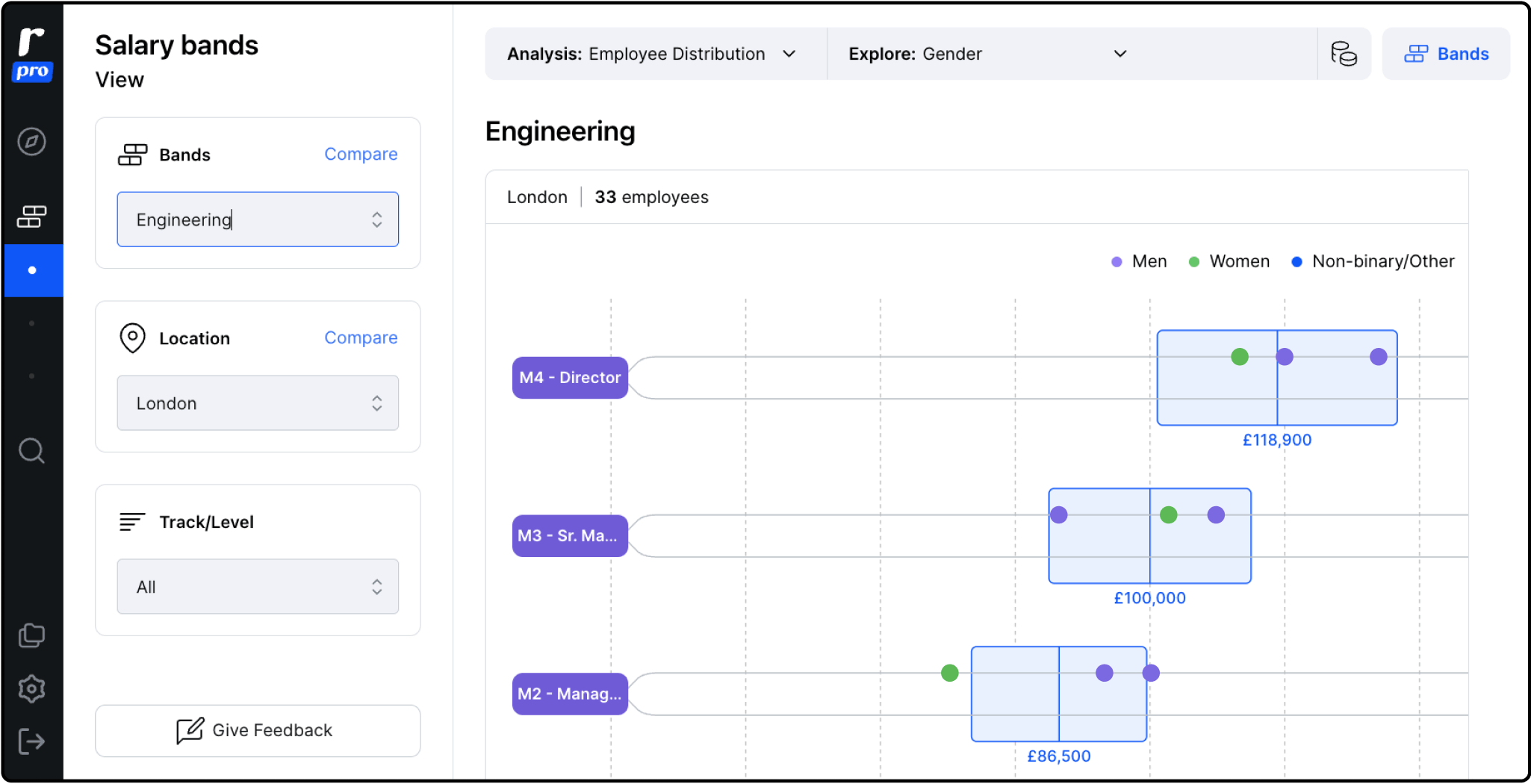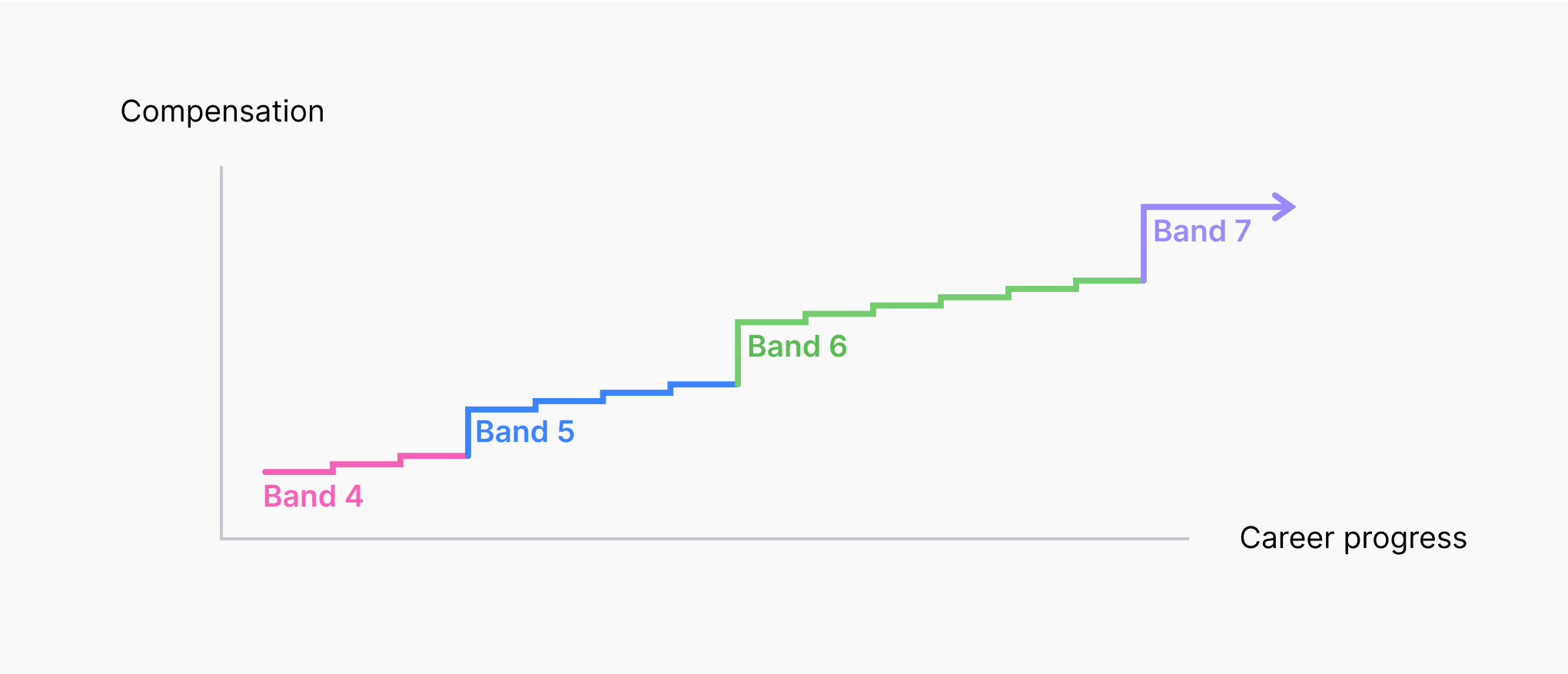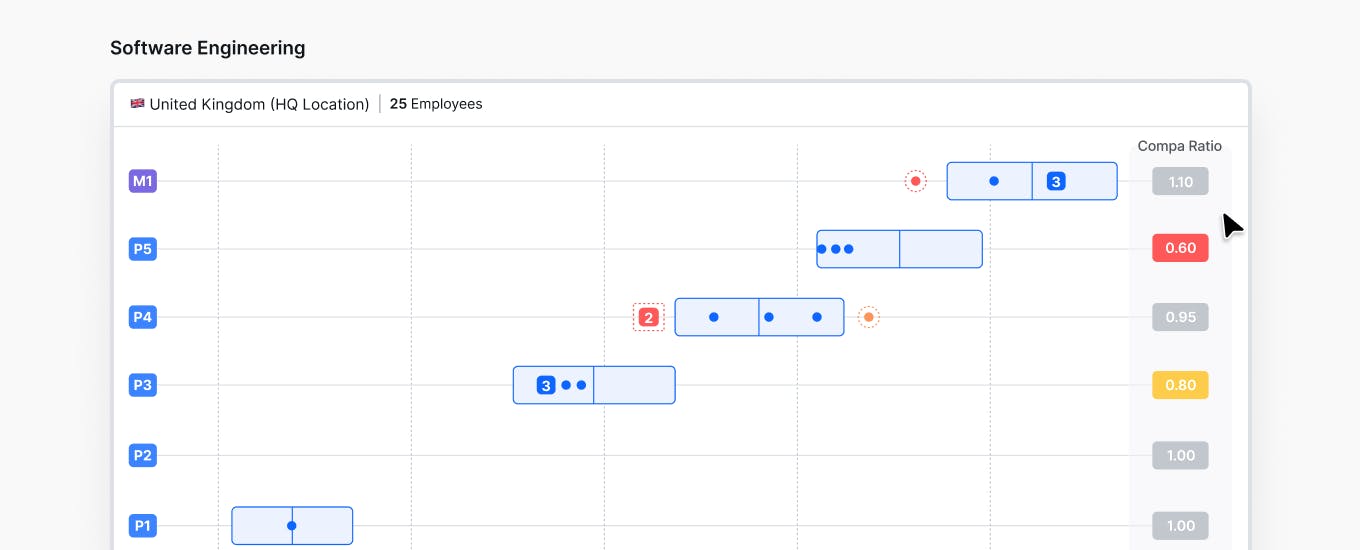The many benefits of salary bands – and how to overcome the one downside

Salary bands are hard to get right.
We all know they have a hugely important role in compensation – ensuring fair and equitable pay, making payroll budgeting simple, enabling clear career progression, and much more.
But they can also be painful – it’s hard to get leadership alignment, the link with fair pay and progression makes them emotionally charged, and often people teams end up creating and managing them in hellish-to-work-with spreadsheets.
So is the chaos really worth it when it comes to implementing salary bands? Let’s explore.
Subscribe to our newsletter for a monthly treasure trove of insights from Ravio's compensation dataset and network of Rewards experts, to help you navigate a career in compensation 📩
5 reasons that salary bands are worth it
Salary bands are a vital part of compensation for any company that cares about:
- Consistent compensation decisions across the entire team
- Better budgeting for compensation changes
- Improved fairness and equity in pay
- Improved pay transparency (and so employee retention)
- Clear pathways for compensation and performance reviews.
Which is pretty much every company – so let’s take a closer look.
Stay in the loop with the latest news, trends and insights from Ravio:
1. Consistent compensation decisions across the entire team
Salary bands offer a formalised structure for compensation within an organisation, aligned with business objectives and career progression paths.
Through this, all decisions about compensation – from what salary to advertise for a new role to what merit raise to offer in this year’s performance review – are well-informed and consistent, with clear rationale behind them.
And that’s crucial, because a number of people within a company are making those compensation-related decisions:
- Talent acquisition: listing the salary range for a new role, negotiating offers with candidates
- Talent management: determining and delivering performance pay increases or bonuses
- Hiring managers: communicating compensation and pay progression with employees
- Finance: budgeting for payroll – one of the top costs at a company
There’s huge value in all of these team members feeling empowered to make compensation decisions because of clearly defined salary bands.
2. Better budgeting
Payroll is typically one of the biggest cost a company has – and a lack of clarity on compensation can lead to tense conversations about budget planning with finance colleagues.
With salary bands, payroll budgeting becomes much easier, for instance:
- New hires: salary bands bring consistency to salary offers, making forecasting costs for new hires possible
- Pay progression and performance reviews: expected career progression is built into the salary bands, making it easy for finance teams to model cost increases.
3. Improved fairness and equity in pay
Through salary bands employees who perform equal work (or work of equal value) are grouped together to ensure they are paid similarly – based on their job position, level, and location.
With a clearly defined set of salary bands in place, it’s easy to identify when pay equity issues arise:
- Internal pay equity: salary band outliers – employees who are being paid above or below their salary band – give a clear indication that there may be issues with internal pay equity.
- Pay gaps: variation in pay amongst employees within a salary band should be explainable through objective measures e.g performance, progression/competencies, length of time in role – if not, it’s an indication that their made be pay discrimination occurring e.g. with the gender pay gap.
And being able to easily identify any issues with pay fairness and equity makes it easier to act quickly and address them.
Plus, simply having salary bands in place can make a big difference in terms of compensation fairness from the word go.
Much pay inequity is created at the start of employment (like we’ve seen with the gender pay gap in tech) through the salary agreed at the point of hire. Having a defined salary band structure already set up with clear minimum, maximum, and target (midpoint) salaries per role helps to eliminate any subjectivity and bias which may take place during the offer stage.

4. Improved pay transparency for employees (and candidates)
Legislation on pay transparency is ramping up.
The EU Pay Transparency Directive, for instance, will soon make it mandatory to include a salary range in job advertisements.
Having clearly defined salary bands makes that super simple.
Aside from legislation, the visibility of salary in job ads is a hot topic right now – so it’s an important one to get right for your employee brand and reputation too.

Recent LinkedIn posts discussing including a salary range in a job advert.
Plus, salary bands improve transparency for existing employees too.
A clearly defined structure of salary bands means that employees can easily understand the rationale behind their compensation, making compensation conversations easier.
And, when employees understand their compensation better they’re more likely to feel fairly compensated, leading to improvements in employee motivation and engagement. In turn, that increases employee retention rates and reduces attrition – we know from a 2022 McKinsey study that inadequate compensation is the number 1 reason for leaving a company.
5. Clear pathways for compensation and performance reviews
Salary bands are fundamental for career progression and performance reviews.
A company’s level framework lays the foundation for what typical career progression looks like and the competencies employees need to demonstrate to progress to the next level.
Salary bands outline how pay will increase as that progress takes place, and how that differs across departments and job positions
The clarity that this structure brings makes it much easier to handle compensation and performance reviews – both in terms of the process itself, and communicating about these topics with employees.

But, there are clear challenges when it comes to salary bands too
The one big downside to salary bands is that they can feel complex.
In a best practice world you have a salary band for every job position and level in your company, plus every location too if you pay employees differently based on location.
That means a lot of salary bands – and that comes with challenges:
- Visualising salary bands isn’t easy (even if you’re great with Excel)
- Making changes to salary bands can mean starting from scratch with analysis
- Different teams often need to see salary bands data in different formats
- Sharing and communicating about salary bands with colleagues and employees can be overwhelming if everything is in a mammoth spreadsheet.
All of which can make creating, managing, and updating salary bands a struggle – which isn’t ideal when they’re so crucial to the success of compensation within a company.
How to get the benefits of salary bands without the downsides
The good news it that there is a way to get all those benefits of granular, best practice salary bands, but without all the complication.
With Ravio you can get your salary bands out of excel and onto a platform where you can seamlessly visualise, manage, evaluate, improve, and even share with colleagues and employees – creating a single source of truth for compensation in your company.

Ravio's salary bands tool.